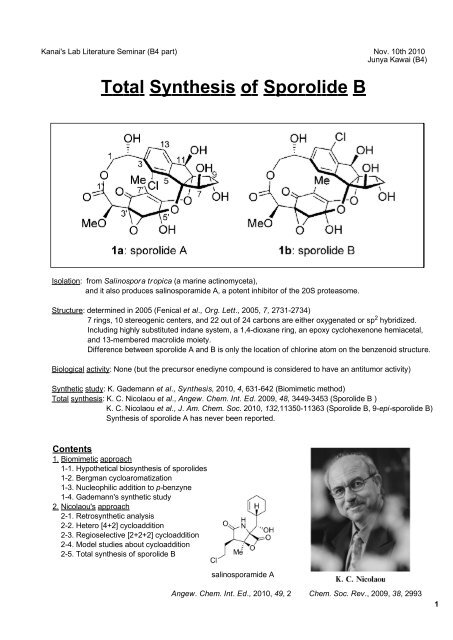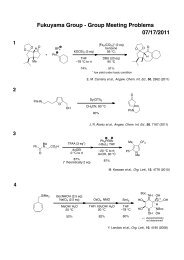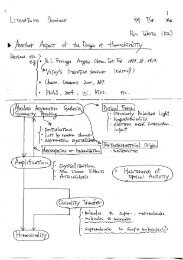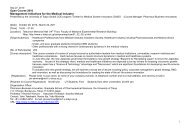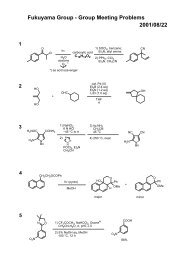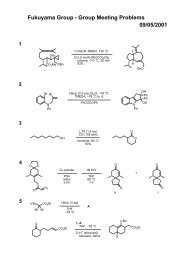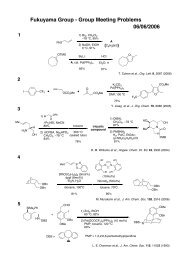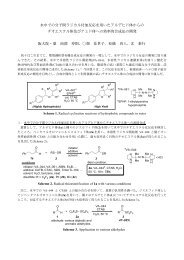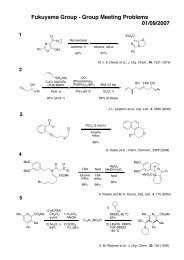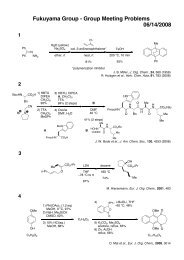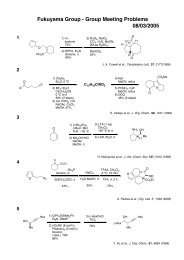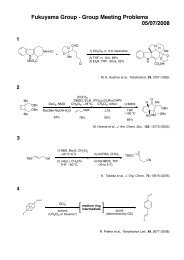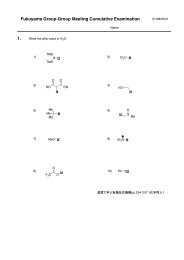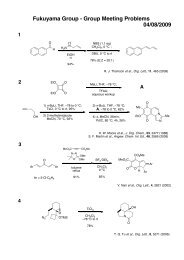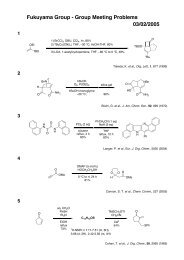Total Synthesis of Sporolide B
Total Synthesis of Sporolide B
Total Synthesis of Sporolide B
Create successful ePaper yourself
Turn your PDF publications into a flip-book with our unique Google optimized e-Paper software.
Kanai's Lab Literature Seminar (B4 part) Nov. 10th 2010<br />
Junya Kawai (B4)<br />
<strong>Total</strong> <strong>Synthesis</strong> <strong>of</strong> <strong>Sporolide</strong> B<br />
Isolation: from Salinospora tropica (a marine actinomyceta),<br />
and it also produces salinosporamide A, a potent inhibitor <strong>of</strong> the 20S proteasome.<br />
Structure: determined in 2005 (Fenical et al., Org. Lett., 2005, 7, 2731-2734)<br />
7 rings, 10 stereogenic centers, and 22 out <strong>of</strong> 24 carbons are either oxygenated or sp 2 hybridized.<br />
Including highly substituted indane system, a 1,4-dioxane ring, an epoxy cyclohexenone hemiacetal,<br />
and 13-membered macrolide moiety.<br />
Difference between sporolide A and B is only the location <strong>of</strong> chlorine atom on the benzenoid structure.<br />
Biological activity: None (but the precursor enediyne compound is considered to have an antitumor activity)<br />
Synthetic study: K. Gademann et al., <strong>Synthesis</strong>, 2010, 4, 631-642 (Biomimetic method)<br />
<strong>Total</strong> synthesis: K. C. Nicolaou et al., Angew. Chem. Int. Ed. 2009, 48, 3449-3453 (<strong>Sporolide</strong> B )<br />
K. C. Nicolaou et al., J. Am. Chem. Soc. 2010, 132,11350-11363 (<strong>Sporolide</strong> B, 9-epi-sporolide B)<br />
<strong>Synthesis</strong> <strong>of</strong> sporolide A has never been reported.<br />
Contents<br />
1. Biomimetic approach<br />
1-1. Hypothetical biosynthesis <strong>of</strong> sporolides<br />
1-2. Bergman cycloaromatization<br />
1-3. Nucleophilic addition to p-benzyne<br />
1-4. Gademann's synthetic study<br />
2. Nicolaou's approach<br />
2-1. Retrosynthetic analysis<br />
2-2. Hetero [4+2] cycloaddition<br />
2-3. Regioselective [2+2+2] cycloaddition<br />
2-4. Model studies about cycloaddition<br />
2-5. <strong>Total</strong> synthesis <strong>of</strong> sporolide B<br />
salinosporamide A<br />
Angew. Chem. Int. Ed., 2010, 49, 2<br />
Chem. Soc. Rev., 2009, 38, 2993<br />
1
1. Biomimetic approach<br />
1-1. Hypothetical biosynthesis <strong>of</strong> sporolides<br />
OH<br />
OH<br />
O<br />
O<br />
MeO<br />
O<br />
O<br />
OH<br />
O<br />
Y Me<br />
X<br />
O<br />
OH<br />
O<br />
3<br />
9-membered enediyne<br />
O<br />
O<br />
O<br />
OH<br />
OH<br />
OH<br />
1a: sporolide A (X=H, Y=Cl)<br />
1b: sporolide B (X=Cl, Y=H)<br />
O<br />
MeO<br />
O<br />
SCoA HO<br />
OH<br />
O<br />
Me<br />
OH<br />
O O<br />
O<br />
pre-sporolide<br />
derived<br />
from 2 building blocks.<br />
OH<br />
Acetyl-CoA Malonyl-CoA<br />
Bergman cycloaromatization<br />
O<br />
OH<br />
SCoA<br />
OH<br />
OH<br />
MeO<br />
O<br />
O<br />
OH<br />
O<br />
S<br />
O<br />
Enz<br />
2<br />
cyclohexenone epoxide<br />
H 2N CO 2H<br />
L-Tyrosine<br />
OH<br />
Biosynthesis toward pre-sporolide is catalyzed by several<br />
polyketide synthases encoded in spo gene cluster.<br />
Moore et al., PNAS, 2007, 104, 10376-10381<br />
Moore et al., J. Am. Chem. Soc., 2008, 130, 2406-2407<br />
pre-sporolide<br />
1-2. Bergman cycloaromatization<br />
R. G. Bergman, Acc. Chem. Res., 1973, 6, 25-31<br />
Basak et al., Chem. Rev., 2003, 103, 4077-4094<br />
R 1<br />
R 2<br />
R 3<br />
R 4<br />
enediyne<br />
(Z)-hex-3-ene-1,5-diyne<br />
1,4-cyclohexadiene<br />
(hydrogen donor)<br />
R 1<br />
R 2<br />
H<br />
H<br />
R 3<br />
R 4<br />
heat<br />
R 1<br />
R 2<br />
R 3<br />
R 4<br />
biradical intermediate<br />
"para-benzyne"<br />
R 1<br />
R 2<br />
Cl<br />
Cl<br />
CCl 4<br />
R 3<br />
R 4<br />
2
Nicolaou et al., J. Am. Chem. Soc., 1988, 110, 4866<br />
Sander et al., Angew. Chem. Int. Ed., 2003, 42, 502-528<br />
Distance between two terminal alkyne moiety is one <strong>of</strong><br />
the key factors <strong>of</strong> reactivity.<br />
Cyclization <strong>of</strong> 27 requires 200 o C (t 1/2 = 30 s), while 10membered<br />
enediyne 62 proceeds smoothly even at 37 o C.<br />
Fenical et al., Org. Lett., 2006, 8, 1024<br />
9-membered enediynes are much more unstable.<br />
In nature, they are stabilized as chlomoprotein.<br />
Once separated from their protein complex, cyclization<br />
occurs rapidly.<br />
Buchwald et al., Science, 1995, 269, 814<br />
For cyclization <strong>of</strong> the acyclic enediyne,<br />
milder temperature can be adopted<br />
by bridging two alkyne moiety<br />
with transition metals.<br />
Niestroj et al., Eur. J. Org. Chem., 1999, 1-13<br />
,<br />
Smith and Nicolaou, J. Med. Chem., 1996, 39, 2103-2117<br />
Hydrogen atom abstraction from DNA leads to<br />
double-strand cleavage.<br />
So, many compounds possesing the enediyne structure<br />
has an antitumor activity.<br />
3
1-3. Nucleophilic addition to p-benzyne<br />
O'Connor et al., J. Am. Chem. Soc., 2007, 129, 4795-4799<br />
OH H<br />
OH<br />
OH<br />
O<br />
Cl<br />
O<br />
Me<br />
O<br />
O OH<br />
O<br />
MeO<br />
O OH<br />
OH Cl<br />
OH<br />
OH<br />
O<br />
H<br />
O<br />
Me<br />
O<br />
O OH<br />
O<br />
MeO<br />
O OH<br />
sporolide A sporolide B<br />
Cyanosporaside A/B (products <strong>of</strong> S. pacif ica), sprolide A/B<br />
were isolated as a 1:1 mixture <strong>of</strong> Cl-positional isomers.<br />
(No dihydro nor dichloro compound was detected.)<br />
Not radicalic pathway.<br />
How is only one Cl incorporated ?<br />
5<br />
LiX, pivalic acid<br />
DMSO-d 6, 37 o C<br />
H/D<br />
8 is partially deuterated, even in absent <strong>of</strong> D 2O.<br />
Reaction rate is just first order in [5] (i.e. -d[5]/ dt = k[5])<br />
and independent <strong>of</strong> [HA], [LiX], and the kind <strong>of</strong> halides.<br />
X<br />
8<br />
Plausible mechanism<br />
Slopes are clearly the same for all.<br />
The intermediate is haloaryl anion 7 (strong base)<br />
which can abstract D + cation from DMSO-d 6.<br />
The rate-limiting step is the cycloaromatization <strong>of</strong> 5 to 6.<br />
Alternative mechanisms <strong>of</strong> cyclization can be excluded due to<br />
the reaction rate order.<br />
Electron transfer from halide to p-benzyne can be rejected,<br />
because it is endothermic (>170 kJ/mol).<br />
If the protonation occured before the chlorination, deuterium<br />
abstraction from DMSO-d 6 would be unreasonable.<br />
A mix <strong>of</strong> transfers <strong>of</strong> an electron pair and a single electron.(10)<br />
Singlet biradical forms a new weak sigma bond between<br />
position 1 and 4, and halide approachs to the sigma antibond,<br />
then nucleophilic displacement occurs. (11, 12)<br />
Calculated study shows this halide addition step is exothermic,<br />
even in water.<br />
Thus, only one chlorine is introduced to either <strong>of</strong> the<br />
two possible positions.<br />
4
1-4. Gademann's synthetic study<br />
Retrosynthetic analysis<br />
esterification<br />
O<br />
O<br />
MeO<br />
O<br />
OH<br />
O<br />
Y<br />
Me<br />
OH<br />
X<br />
O<br />
1a: sporolide A (X=H, Y=Cl)<br />
1b: sporolide B (X=Cl, Y=H)<br />
O<br />
O<br />
O<br />
O<br />
O<br />
OH<br />
H<br />
OH<br />
OH<br />
H O<br />
H<br />
O<br />
TBS<br />
33<br />
macrocyclization<br />
H O<br />
TfO<br />
H<br />
Biomimetic approach through Bergman cycloaromatization <strong>of</strong> 9-membered enediyne ring.<br />
If this route succeeded, a 1:1 mixture <strong>of</strong> both isomers could be obtained at the same time.<br />
O<br />
Sonogashira<br />
cross-coupling<br />
34 35<br />
The most challenging point is the high rigidity <strong>of</strong> 9-membered enediyne moiety.<br />
OTBS<br />
O<br />
O<br />
Acetylide<br />
attack<br />
OH<br />
MeO<br />
O<br />
O<br />
30<br />
Me<br />
O<br />
OH<br />
PGO<br />
HO<br />
Bergman<br />
cycloaromatization<br />
HO<br />
O<br />
OPG<br />
32<br />
X<br />
Y<br />
HO<br />
H<br />
31<br />
OPG<br />
OPG<br />
OH<br />
H<br />
OPG<br />
OPG<br />
OH<br />
H<br />
OPG<br />
9-membered enediyne intermediate<br />
2-cyclopenten-1-one<br />
5
Strategy 1) 9-membered enediyne ring K. Gademann et al., <strong>Synthesis</strong>, 2010, 4, 631-642<br />
O<br />
12 steps<br />
2-cyclopenten-1-one<br />
O<br />
O<br />
H O<br />
Hirama et al., Chem. Lett., 1998, 27, 959<br />
H<br />
O H<br />
CeCl 3/LiN(TMS) 2 (15eq.),<br />
THF (1mM); SM<br />
25 o C, 3h<br />
H<br />
O<br />
O<br />
CeCl 3, LiCl,<br />
LiN(SiMe 2Ph) 2<br />
-78 ~ 0 o C<br />
O<br />
O<br />
H<br />
OH<br />
OH<br />
Bergman<br />
cycloaromatization<br />
OH<br />
Lower temperature (10% yield.<br />
No TM<br />
O<br />
up to 35% yield<br />
Thus, high temp. is required for intramolecular acetylide attack to enediyne, because <strong>of</strong> the rigidity <strong>of</strong> structure<br />
which came from two sp 2 hybridized centers. But in this case, higher temp. made serious side reactions.<br />
Strategy 2) 9-membered diyne ring<br />
HO<br />
O<br />
OPG<br />
HO<br />
36<br />
9 steps<br />
OPG<br />
OH<br />
H<br />
OPG<br />
O<br />
O<br />
33<br />
H<br />
37<br />
OH<br />
Target structure;<br />
9-membered ring diyne core without two sp 2 hybridized centers<br />
(Less rigid structure than enediyne)<br />
H<br />
DMP<br />
87%<br />
Target structure was not formed in various conditions.<br />
A. Yamashita et al., J. Am. Chem. Soc., 1975, 97, 891<br />
Allenes are known to undergo isomerization to alkynes under strong base condition.<br />
So, they continued the synthesis using allene 39.<br />
O<br />
O<br />
O<br />
O<br />
H<br />
H<br />
O<br />
39<br />
O<br />
38<br />
H<br />
H<br />
H<br />
O<br />
6
O<br />
O<br />
H<br />
O<br />
R<br />
OH<br />
Cascade system toward formation <strong>of</strong><br />
9-membered ring failed under 22 conditions.<br />
O<br />
O<br />
O<br />
O<br />
H<br />
H<br />
O<br />
O<br />
R<br />
39<br />
H<br />
43: R = H<br />
44: R = Me<br />
45: R = TBS<br />
H<br />
H<br />
H<br />
OTBS<br />
O<br />
O<br />
O<br />
O<br />
KAPA<br />
O<br />
O<br />
O<br />
O<br />
H<br />
H<br />
Simple isomerization also failed.<br />
O<br />
R<br />
O<br />
R<br />
H<br />
H<br />
H<br />
Strong base<br />
Lewis acid<br />
Temperature<br />
KAPA: Potassium 3-(aminopropyl)amide; prepared from KH & 3-aminopropylamine in situ.<br />
Yamishita et al., Chem. Commun., 1976, 959<br />
O<br />
O<br />
H<br />
H<br />
O<br />
O<br />
O<br />
O<br />
O<br />
O<br />
R<br />
Conclusion<br />
9-membered enediyne ring is very difficult to construct due to the high rigidity <strong>of</strong> the structure.<br />
It is still uncertain whether the strategy <strong>of</strong> forming 9-membered diyne ring is promising or not.<br />
O<br />
H<br />
40: R = H<br />
41: R = TMS<br />
42: R = Me<br />
OTBS<br />
O<br />
O<br />
7
2. Nicolaou's approach<br />
2-1. Retrosynthetic analysis<br />
esterification<br />
(failed)<br />
O<br />
O<br />
MeO<br />
O<br />
Me<br />
O<br />
OH<br />
O<br />
Me<br />
OH<br />
Cl<br />
O<br />
1b: sporolide B<br />
O<br />
OBn<br />
19<br />
AcO<br />
O<br />
Me<br />
O<br />
OMe<br />
O<br />
OH<br />
OH<br />
OH<br />
hetero [4+2] cycloaddition<br />
O<br />
OH<br />
OBn<br />
O<br />
OMe<br />
4<br />
HO<br />
K. C. Nicolaou et al., Angew. Chem. Int. Ed., 2009, 48, 3449-3453<br />
K. C. Nicolaou et al., J. Am. Chem. Soc., 2010, 132, 11350-11363<br />
Instead <strong>of</strong> biomimetic way, they proposed the approach through two unusual cycloadditions;<br />
Intramolecular hetero [4+2] cycloaddition, and ruthenium-catalyzed [2+2+2] cycloaddition.<br />
esterification<br />
O<br />
OH<br />
20<br />
OH<br />
O<br />
Me<br />
O<br />
OBn<br />
Cl<br />
O<br />
OMe<br />
esterification<br />
(failed)<br />
Cl<br />
O<br />
2<br />
acetylide<br />
addition<br />
Li<br />
OAc<br />
Cl<br />
OAc<br />
HO<br />
OBn<br />
[2+2+2] cycloaddition<br />
OAc OBn<br />
3<br />
TMS<br />
OTBS<br />
O<br />
11<br />
OBn<br />
OTBS<br />
8
2-2. Hetero [4+2] cycloaddition<br />
(a) hetero 2e component (b) hetero 4e component<br />
X [4+2] X<br />
X<br />
[4+2]<br />
X<br />
Y<br />
X = O, Y = CR2 (carbonyl)<br />
X = Y = NR<br />
Y<br />
Y<br />
X = O, Y = CR2 (enone)<br />
X = Y = O (1,2-dicarbonyl)<br />
Nicolaou's Method<br />
Y<br />
[4+2] cycloaddition <strong>of</strong> 1,2-dicarbonyl moiety<br />
R<br />
O<br />
O<br />
o-quinone<br />
(o-benzoquinone)<br />
R 1<br />
R 3<br />
Cycloaddition <strong>of</strong> substituted ortho-quinones has only been reported.<br />
(Simple o-quinones are so unstable that they are rapidly dimerized.)<br />
Difficulties: (1) Two stable C=O bonds<br />
(2) Lower HOMO energy than C=C bond<br />
(3) Existence <strong>of</strong> other 2e/4e systems<br />
In order to overcome: (1) Aromatization <strong>of</strong> o-quinones<br />
(2) Introduction <strong>of</strong> EDG / Using LUMO <strong>of</strong> o-quinone<br />
(3) Steric effect<br />
R 2<br />
R 4<br />
V. Nair et al., Synlett., 1996, 1143-1147<br />
o-quinone has 4 possible reactive points.<br />
Reglier et al., Tet. Lett., 2004, 45, 8011-8013<br />
t-Bu<br />
O<br />
HO<br />
O<br />
-<br />
t-Bu O Ph O<br />
flavonol<br />
toluene<br />
reflux, 10h<br />
Regioselectivity seems to be based on the partial polarization.<br />
R<br />
O R 1<br />
O<br />
R 2<br />
R4 R3 1,4-dioxane derivative<br />
C-C : 340-350 kJ/mol<br />
C-O : 350-380 kJ/mol<br />
C=C: 600-625 kJ/mol<br />
C=O: 725-760 kJ/mol<br />
aromatization : 140 kJ/mol<br />
(Ref. Warren)<br />
t-Bu<br />
O<br />
t-Bu O<br />
O<br />
OH<br />
O<br />
Ph<br />
55% (racemic)<br />
9
P. G. Jones et al., Eur. J. Org. Chem., 2006, 335-350<br />
all-carbon diene as 4e system o-quinone derivative<br />
heterodiene moiety as 4e system<br />
toluene<br />
reflux<br />
62% yield<br />
Reactivity <strong>of</strong> each diene-system seems to depend on the structural bulkiness <strong>of</strong> dienophile.<br />
reacts with all-carbon diene reacts with both (gives mixture)<br />
reacts with heterodiene moiety<br />
10
2-3. Regioselective [2+2+2] cycloaddition<br />
Y. Yamamoto et al., Chem. Rev., 2000, 100, 2901-2915<br />
General mechanism<br />
M = Co, Ni, Rh, Ru, Pd and many other kinds <strong>of</strong> metals<br />
are available today.<br />
Generally, highly regioselective synthesis is achieved<br />
in partially / totally intramolecular system.<br />
Holmquist et al., J. Am. Chem. Soc., 1995, 117, 6605-6606<br />
10 mol%<br />
(10 eq.)<br />
Willkinson's catalyst was used.<br />
Steric repulsion causes regioselectivity.<br />
meta-substituted benzene can be synthesized<br />
through this approach.<br />
K. Itoh et al., Chem. Commun., 2000, 549-550<br />
K. Itoh et al., J. Am. Chem. Soc., 2003, 125, 12143-12160<br />
Catalyst screening in entry 1 (above)<br />
5a<br />
Cp*RuCl(cod) gives the greatest meta-selectivity.<br />
The bulky Cp* ligand is important for the high selectivity.<br />
(Cp* = pentamethylcyclopentadienyl)<br />
For regioselective synthesis <strong>of</strong> pyridine derivatives,<br />
see Mr. Saito's literature seminar.<br />
6a<br />
11
2-4. Model studies about cycloaddition<br />
Intermolecular [4+2] cycloaddition ~ model study<br />
In the first retrosynthetic analysis, they proposed 2 pathways.<br />
Path a: Intermolecular [4+2] and following lactonization<br />
Path b: Esterification and following intramolecular [4+2]<br />
But intramolecular [4+2] cycloaddition might be problematic,<br />
due to the limited conformation.<br />
So they adopted the intermolecular [4+2] system (Path a)<br />
as an initial study.<br />
o-quinone has two kinds <strong>of</strong> diene system: all-carbon diene, and hetero diene moiety.<br />
All-carbon diene has much higher reactivity for [4+2], but is more sterically hindered.<br />
Indene 16 gives only undesired products. (all-carbon diene is much more reactive.)<br />
But more crowded indene derivative 18 gives desired products in good yield.<br />
Steric repulsion <strong>of</strong> dienophile can reverse the reactivity <strong>of</strong> diene system !<br />
In case <strong>of</strong> enone 20, all-carbon diene reacts, despite the steric repulsion.<br />
Me<br />
O<br />
O<br />
hetero diene<br />
In all cases, regioselectivity can be explained by assuming polarization.<br />
(diene: electron donation from OBn group. dienophile: conjugation with phenyl or carbonyl group.)<br />
OBn OMe<br />
6<br />
O<br />
OEt<br />
all-carbon<br />
diene<br />
12
Failed attempts through macrolactonization<br />
Me<br />
O<br />
OBn OMe<br />
O<br />
Macrocycle<br />
6<br />
O<br />
OEt<br />
OH<br />
HO<br />
O<br />
HO<br />
MeO<br />
BnO<br />
7<br />
OH<br />
Me<br />
O<br />
O<br />
toluene<br />
115 o C, 3h<br />
62%<br />
3 steps<br />
O<br />
OEt<br />
MeO<br />
HO<br />
BnO<br />
O<br />
OEt<br />
MeO<br />
HO<br />
BnO<br />
Me<br />
O<br />
6,7-TS<br />
Macrolactnization failed in 6 activation conditions (Corey-Nicolaou, Mukaiyama salt, Mitsunobu, etc.)<br />
Due to overwhelming strain within the expected transition state for the macrolactonization...?<br />
Change the method to Path b (esterification & following intramolecular [4+2] cycloaddition)<br />
Intramolecular [4+2] cycloaddition ~ model study<br />
<strong>Sporolide</strong> model system<br />
Ag 2O<br />
120 o C<br />
t BuOOH<br />
DBU<br />
60%<br />
In model study, desired macrocycle was formed as a single diastereoisomer.<br />
40<br />
H<br />
1) PMBOH<br />
PIFA<br />
87%<br />
2) DDQ<br />
96%<br />
Bn<br />
Me<br />
O<br />
O<br />
O<br />
38<br />
1 step, 60% yield<br />
H<br />
39<br />
H 2<br />
Pd(OH) 2<br />
85%<br />
13
Diastereoselectivity <strong>of</strong> model study<br />
Diastereo- & regioselectivity is fully controled<br />
by partial polarization and 1,3-allylic strain.<br />
Strategy change from esterification to [2+2+2] cycloaddition<br />
difficult to construct<br />
To synthesize precursor VII through esterification, VIII and IX<br />
is necessary.<br />
Though synthesis <strong>of</strong> VIII was achieved, IX was difficult to<br />
construct, presumably due to sensitive & crowded nature.<br />
As an alternative strategy to synthesize precursor VII,<br />
metal-catalyzed [2+2+2] cycloaddition was adopted.<br />
14
O<br />
Failed attempt to sporolide B system through intramolecular [4+2] cycloaddition<br />
O<br />
MeO<br />
Possible selectivity <strong>of</strong> [2+2+2] cycloaddition<br />
O<br />
O<br />
MeO<br />
O<br />
OH<br />
O<br />
O<br />
OH<br />
O<br />
Y Me<br />
Me<br />
OH<br />
Cl<br />
O<br />
OH<br />
1b: sporolide B<br />
O<br />
O<br />
O<br />
OH<br />
HO<br />
OH<br />
77% yield<br />
9<br />
OH<br />
OH<br />
OH<br />
1a: sporolide A (X = H, Y = Cl)<br />
2a: sporolide B (X = Cl, Y = H)<br />
X<br />
hetero [4+2]<br />
In case <strong>of</strong> fully substituted precursor 62, [4+2] cycloaddition didn't occur at all,<br />
due to the steric clash between o-quinone moiety and down-directed OBn group at C-9 position.<br />
To overcome this problem, new substrate with the C-9 inverted stereochemistry was essencial.<br />
O<br />
Me<br />
O<br />
OBn<br />
O<br />
OMe<br />
O<br />
62<br />
OAc<br />
X<br />
Y<br />
OAc<br />
HO<br />
sporolide A: ortho position (unfavor)<br />
sporolide B: meta position (favor)<br />
Considering the regioselectivity <strong>of</strong> [2+2+2] cycloaddition,<br />
the substituted group (o-quinone moiety) and chlorine atom will locate in meta position.<br />
Only sporolide B can be synthesized through [2+2+2] cycloaddition !<br />
9<br />
OBn<br />
9<br />
15
2-5. <strong>Total</strong> synthesis <strong>of</strong> sporolide B<br />
<strong>Synthesis</strong> <strong>of</strong> building block 3<br />
Curran et al., Tetrahedron, 1997, 53, 1983<br />
Braun et al., J. Am. Chem. Soc., 1993, 115, 11014<br />
TMS<br />
O<br />
I<br />
O<br />
OTBS<br />
5<br />
>99% ee<br />
OTHP<br />
I<br />
10<br />
O<br />
OH<br />
furfuryl alcohol<br />
4,200 YEN/ 50G (Ald)<br />
OBn<br />
OTBS<br />
1) NaBH 4, CeCl 3 . 7H2O<br />
MeOH, -78 o C, 1h<br />
2) NaH, THF; BnBr, TBAI<br />
0 o C to rt, 16h<br />
(95%, ca. 10:1 dr)<br />
1) NaBH 4, CeCl 3 . 7H2O<br />
MeOH, -78 o C, 1h<br />
2) TBSCl, imid., DMAP<br />
CH 2Cl 2, rt, 3h<br />
(94%, ca. 10:1 dr)<br />
1) PdCl2(PPh3) 2 (2 mol%),<br />
CuI (4 mol%), Et2NH, rt, 16h (98%)<br />
2) Et2AlCl, CH2Cl2, -25o TMS<br />
C to rt, 2h (99%)<br />
3) DMP, NaHCO3, CH2Cl2, rt, 1h (79%)<br />
11<br />
2 steps<br />
OBn<br />
OTBS<br />
HO<br />
cis-1,4-cyclopentenediol<br />
68,500 YEN/ 2.5g (Ald)<br />
I<br />
6<br />
OBn<br />
OTBS<br />
OTHP<br />
I<br />
9<br />
PdCl 2(PPh 3) 2 (5 mol%)<br />
CO (balloon), Et 3N<br />
MeOH, 70 o C, 3h (95%)<br />
MeO<br />
7<br />
1) DIBAL (2.5eq.), toluene<br />
-78oC to -10oC, 1h (95%)<br />
2) DHP, TsOH . H2O, CH2Cl2, 0oC, 30min.<br />
3) TBAF, THF, rt, 3h<br />
OBn<br />
O<br />
1) DMP, NaHCO 3, CH 2Cl 2, rt,<br />
30min. (83% over 3 steps)<br />
2) I 2, CH 2Cl 2/Pyridine (1:1)<br />
rt, 15h (80%)<br />
O<br />
I<br />
OBn<br />
OTBS<br />
OTHP<br />
8<br />
O<br />
OTBS<br />
(4.5 eq.)<br />
MeLi (3.0 eq.), Et2O 0o Cl Cl OH OBn<br />
O OBn<br />
C, 30min.; Cl<br />
DMP, NaHCO3 Cl<br />
then 11, 0 o C, 10min.<br />
(ca. 5:1 dr)<br />
Cl<br />
OH<br />
OAc<br />
3<br />
SP-435 (Lipase)<br />
isopropenyl acetate<br />
TMS<br />
50%, 98% ee<br />
12<br />
OTBS<br />
undesired diastereomer<br />
OBn<br />
OTBS<br />
AcO<br />
CH 2Cl 2, rt, 1h<br />
93% (2 steps)<br />
1) K 2CO 3, MeOH<br />
rt, 1h (99%)<br />
(TMS deprotection)<br />
2) Ac 2O, Et 3N, DMAP<br />
CH 2Cl 2, 0 o C, 30min.<br />
(98%)<br />
OH<br />
TMS<br />
DIBAL (1.5 eq.), toluene<br />
-78 o C, 30min. (ca. 7:1 dr)<br />
Cl<br />
TMS<br />
4 steps<br />
OH<br />
13<br />
5<br />
OBn<br />
OH<br />
OBn<br />
OTBS<br />
OTBS<br />
14 (81% pure isomer)<br />
16
stereoselectivity <strong>of</strong> propargylic alcohol 12 and 14<br />
12 14: direct Mitsunobu rxn failed.<br />
oxidation-reduction was adopted.<br />
Chelation-controled TS<br />
carbonyl group is directed to up-side.<br />
Lithium chloroacetylide is formed in situ.<br />
<strong>Synthesis</strong> <strong>of</strong> building block 4<br />
11-TS<br />
The configurations <strong>of</strong> 12/14 were determined by NMR (NOE?) <strong>of</strong> derivatives, prepared by [2+2+2] cycloaddition.<br />
Cl<br />
TMS<br />
OH<br />
12 or 14<br />
OBn<br />
OTBS<br />
OTBS<br />
(S) OPMB<br />
Ru-catalyzed<br />
[2+2+2] cycloaddition<br />
A. Kubo et al., J. Chem. Soc. Perkin Trans. 1, 1997, 53-69<br />
O<br />
O<br />
Piperonal<br />
5,100 YEN /100G<br />
mCPBA;<br />
KOH-H 2O,<br />
MeOH<br />
O<br />
O<br />
Sesamol<br />
13,200 YEN /25G<br />
MOMCl<br />
DMF<br />
PMBO<br />
TBSO<br />
O H OH OMOM<br />
O<br />
Me<br />
Cl Cl<br />
H H<br />
O<br />
OBn O<br />
15<br />
H<br />
MeLi<br />
BnX<br />
LiCl, CH 4<br />
H Cl<br />
O<br />
Me<br />
O<br />
OH O<br />
MeLi<br />
H<br />
O<br />
O<br />
CH 4<br />
N N<br />
Cl<br />
N<br />
HO<br />
TMS<br />
n BuLi, THF;<br />
N<br />
MeI<br />
(hexamethylenetetraamine)<br />
AcOH<br />
Li<br />
Cl<br />
13<br />
OBn<br />
OTBS<br />
O<br />
Me<br />
HCl<br />
EtOH<br />
O<br />
Me<br />
O<br />
OMOM<br />
O<br />
OH<br />
17
<strong>Synthesis</strong> <strong>of</strong> building block 4<br />
O<br />
Me<br />
O<br />
Me<br />
O<br />
OBn O<br />
15<br />
O<br />
Me<br />
O<br />
H<br />
OBn OMe<br />
19<br />
O<br />
Preparation <strong>of</strong> 20<br />
O<br />
Ph 3P CH 2<br />
THF, 0 o C, 30min.<br />
(98%)<br />
OH<br />
20, EDCI, DMAP<br />
CH 2Cl 2, 25 o C, 3h (73%)<br />
OBn OMe<br />
21<br />
Yadav et al.,Tet. Lett.,1988, 29, 2737<br />
HO<br />
O<br />
OH<br />
OH<br />
D-(-)-tartaric acid<br />
OH<br />
20<br />
O<br />
OH<br />
OH<br />
O<br />
O<br />
O<br />
Me<br />
O<br />
OBn<br />
16<br />
H<br />
AD-mixt<br />
BuOH/H2O (1:1)<br />
25 o C, 8h<br />
(96%, 98% ee)<br />
O<br />
Me<br />
O<br />
OBn<br />
1) TBSCl, Et 3N, DMAP, CH 2Cl 2, 25 o C, 8h (99%)<br />
2) t BuOK, MeI, MeCN, 0 to 25 o C, 16h (95%)<br />
3) TBAF, THF, 25 o C, 16h (99%)<br />
1) DMP, NaHCO 3, CH 2Cl 2, 25 o C, 1h (78%)<br />
2) NaClO 2, NaH 2PO 4 . 2H2O, 2-methyl-2-butene<br />
t BuOH/H2O (1:1), 25 o C, 30min. (96%)<br />
Pinnick oxidation<br />
OH<br />
2 steps<br />
DDQ (2 eq.)<br />
CH 2Cl 2/H 2O<br />
HO<br />
HO<br />
20<br />
Pb(OAc) 4<br />
OH<br />
benzene, 75 o C, 1h<br />
(89%)<br />
O O<br />
OH<br />
OH<br />
OPMB<br />
AcO<br />
O<br />
Me<br />
NaH (1 eq.)<br />
O<br />
O<br />
Me<br />
O<br />
OBn<br />
O<br />
OBn OMe<br />
HO<br />
4<br />
18<br />
O<br />
PMBBr (1 eq.) O O<br />
LiNH 2 (6 eq.)<br />
liquid NH 3<br />
PPh 3<br />
CCl 4, reflux<br />
Cl<br />
O O<br />
17<br />
OMe<br />
OH<br />
OH<br />
OH<br />
OPMB<br />
OPMB<br />
OH<br />
18
18 19 : Dess-Martin oxidation & Pinnick Oxidation<br />
Dess-Martin oxidation: A milder oxidation method <strong>of</strong> alcohol aldehyde (cf. Swern oxid.)<br />
Pinnick oxidation: A milder oxidation method <strong>of</strong> aldehyde carboxylic acid<br />
Aldehyde-selective oxidation (alcohol, alkene etc. are not oxidized.)<br />
(2-methyl-2-butene is the hypochlorous acid scavenger.)<br />
If Mn(VII) or Cr(VI) is used (1 step oxidation), benzylic oxidation may also occur.<br />
R OH<br />
18<br />
DMP oxid.<br />
19 21 : Milder condensation<br />
R<br />
R<br />
O<br />
H<br />
O H<br />
H<br />
H<br />
Cl<br />
O Cl<br />
O<br />
O<br />
Pinnick oxid.<br />
O R<br />
EDCI = 1-(3-dimethylaminopropyl)-3-ethylcarbodiimide hydrochloride<br />
HCl<br />
Me<br />
Me<br />
21 4: Radicallic cleavage?<br />
N<br />
N C N Me<br />
Chepelev et al., J. Org. Chem., 2003, 68, 7023-7032<br />
(AcO) 3Pb<br />
Me<br />
O<br />
O<br />
H<br />
O<br />
Me<br />
O<br />
OBn<br />
21<br />
R<br />
- AcOH<br />
(AcO) 2Pb<br />
Me<br />
O<br />
O<br />
O<br />
Me<br />
R<br />
O<br />
O<br />
O<br />
H<br />
19<br />
H<br />
Me<br />
OBn<br />
OH<br />
R<br />
O<br />
Cl<br />
Me<br />
O<br />
N<br />
H O Cl<br />
hypochlorous acid<br />
Me<br />
N<br />
Cl<br />
N<br />
H<br />
- Pb(OAc) 2<br />
AcO OAc<br />
I<br />
OAc<br />
O<br />
O<br />
Dess-Martin<br />
Periodinane<br />
AcO<br />
O<br />
Me<br />
4<br />
O<br />
OBn<br />
R<br />
19
AcO<br />
O<br />
Me<br />
HO<br />
Me<br />
<strong>Synthesis</strong> <strong>of</strong> o-quinone derivative 2 (through Ru-catalyzed [2+2+2] cycloaddition)<br />
AcO<br />
O<br />
Me<br />
O<br />
Cl<br />
O<br />
OBn<br />
OH<br />
OBn<br />
OAc<br />
3 (1.1 equiv.)<br />
O<br />
OBn OMe<br />
O<br />
4 (1.0 equiv)<br />
O<br />
OMe<br />
O<br />
OBn<br />
OTBS<br />
OH<br />
22 (87% yield)<br />
O<br />
OMe<br />
O<br />
23<br />
OH<br />
Cl<br />
TBSO<br />
Ru Cl<br />
DCE, 25 o C, 30min.<br />
Oxidative addition<br />
OAc<br />
OBn<br />
Reductive<br />
elimination<br />
AcO<br />
O<br />
Me<br />
AcO<br />
O<br />
Me<br />
1) Ac 2O, Et 3N, DMAP, CH 2Cl 2, 0 o C, 30min. (92%)<br />
2) aq. HF (excess), MeCN, 25 o C 30min.;<br />
then MeOH(excess), 25 o C, 3h (74%)<br />
deprotection <strong>of</strong> TBS & acetoxy acetal group<br />
OAc<br />
Cl<br />
OAc<br />
HO<br />
(7 mol%)<br />
O<br />
OBn<br />
Ag2O (2.5 eq.)<br />
CH 2Cl 2, 25 o C,<br />
30min. (94%)<br />
O<br />
Cl<br />
*Cp<br />
Ru<br />
Cl<br />
O<br />
OBn OMe<br />
O<br />
O<br />
OBn OMe<br />
OAc<br />
TBSO<br />
3-TSa<br />
Free-hydroxy group directing<br />
alkyne coordination<br />
Me<br />
O<br />
Alkyne insertion<br />
to metallacycle<br />
O<br />
OBn<br />
O<br />
3-TSc<br />
O<br />
OMe<br />
O<br />
OBn<br />
*Cp Cl Cl<br />
*Cp<br />
OH<br />
2<br />
Ru<br />
OH<br />
Cl<br />
Ru<br />
OAc<br />
3-TSb<br />
Cl<br />
TBSO<br />
Cl<br />
OAc<br />
TBSO<br />
OAc<br />
OAc<br />
HO<br />
OBn<br />
OBn<br />
OBn<br />
20
O<br />
Several Studies about [2+2+2] cycloaddition step<br />
O<br />
MeO<br />
AcO<br />
O<br />
Me<br />
3<br />
4<br />
4<br />
4<br />
22<br />
87% yield<br />
Regioselectivity is completely controled by steric effect ! (No ortho-regioisomer was observed at all)<br />
Free hydroxy group <strong>of</strong> 4 fastens the reaction, because <strong>of</strong> the possible coordination onto ruthenium nucleus.<br />
When propargylic alcohol 4 was acetylated in advance, reaction rate got significantly slower (ca. 10-fold) and<br />
regioselectivity decreased (ca. 10:1).<br />
Wilkinson's catalyst Rh(PPh 3) 3Cl can also catalyze this cycloaddition (meta:ortho 20:1, 85% combined yield).<br />
For this time, erosion <strong>of</strong> regioselectivity was also observed (20:1 10:1), when acetyl-protected 4 was used.<br />
<strong>Sporolide</strong> A cannot be synthesized through the same method !<br />
O<br />
O<br />
OH<br />
O<br />
Cl<br />
Me<br />
OH<br />
O<br />
OBn OMe<br />
O<br />
O<br />
O<br />
OH<br />
OH<br />
OH<br />
1a: sporolide A<br />
Cl<br />
OH<br />
OAc<br />
OBn<br />
OTBS<br />
O<br />
Me<br />
O<br />
Cp*RuCl(cod)<br />
O<br />
O<br />
OAc<br />
OBn OMe OH Cl<br />
HO<br />
ortho-substituted component is required.<br />
Me<br />
O<br />
OBn<br />
OMe<br />
O<br />
O<br />
OH<br />
22'<br />
O Cl<br />
OBn<br />
Undesired meta-substituted compound.<br />
OAc<br />
HO<br />
OBn<br />
21
O<br />
O<br />
Me<br />
O<br />
MeO<br />
O<br />
<strong>Synthesis</strong> <strong>of</strong> <strong>Sporolide</strong> B from 2 (through hetero [4+2] cycloaddition)<br />
O<br />
MeO<br />
O<br />
O<br />
O<br />
OBn<br />
O<br />
MeO<br />
OAc<br />
O<br />
OH<br />
O<br />
HO<br />
Me<br />
26<br />
O<br />
OMe<br />
OAc<br />
25<br />
O<br />
2<br />
Cl<br />
O<br />
OAc<br />
O<br />
OAc<br />
Cl<br />
OAc<br />
HO<br />
OH<br />
9<br />
Me OTES<br />
PIFA (1.5 eq.), PMBOH, K 2CO 3<br />
MeCN, 0 o C, 30min. (75%)<br />
Oxidative dearomatization<br />
Cl<br />
O<br />
OPMB<br />
Me<br />
OH<br />
O<br />
Cl<br />
O<br />
1b: sporolide B<br />
OAc<br />
OH<br />
9 OTES<br />
O<br />
1) DMP, CH 2Cl 2,<br />
25 o C, 1h (90%)<br />
2) aq. HF (excess)<br />
MeCN, 25 o C, 2h<br />
(85%)<br />
OH<br />
OH<br />
OH<br />
O<br />
9<br />
OBn<br />
O<br />
MeO<br />
t BuOOH (10 eq.)<br />
DBU, CH 2Cl 2,<br />
40 o C, 3h (63%)<br />
toluene, 110 o C, 1.5h<br />
1) TESOTf, Et 3N, CH 2Cl 2<br />
0 o C, 30min. (90%)<br />
2) H 2, Pd(OH) 2/C<br />
EtOAc, 25 o C, 4h (92%)<br />
F 3C<br />
O<br />
O<br />
OAc<br />
O<br />
27<br />
O<br />
MeO<br />
Ph<br />
I<br />
O O<br />
Me<br />
PIFA<br />
Cl<br />
O<br />
OPMB<br />
O<br />
OH<br />
O<br />
O<br />
O<br />
MeO<br />
BnO<br />
OAc<br />
Me<br />
2-TS<br />
Intramolecular<br />
hetero [4+2] cycloaddition<br />
O<br />
OAc<br />
CF 3<br />
O<br />
OH<br />
O<br />
O<br />
MeO<br />
O<br />
BnO<br />
OAc<br />
Me 4NBH(OAc) 3 (10 eq.)<br />
MeCN/AcOH (10:1)<br />
25 o C, 2h (85%)<br />
Me<br />
OH<br />
29<br />
9<br />
Cl<br />
O<br />
O<br />
OH<br />
OH<br />
Cl<br />
O<br />
Cl<br />
O<br />
O<br />
OAc<br />
O<br />
OAc<br />
OBn<br />
OH<br />
OBn<br />
9<br />
Me OH<br />
24<br />
(40% yield based on<br />
ca. 50% conversion)<br />
O<br />
MeO<br />
OH<br />
O<br />
OAc<br />
28<br />
Me<br />
Cl<br />
O<br />
OPMB<br />
O<br />
OAc<br />
OH<br />
9<br />
OH<br />
1) DDQ (5 eq.), CH2Cl2/H2O (10:1)<br />
25oC, 5h (70%)<br />
2) DBU, CH2Cl2/MeOH (3:1)<br />
40oC, 4h (78%)<br />
22<br />
9
25 26: Oxidative dearomatization by PIFA (formation <strong>of</strong> p-benzoquinone monoacetal)<br />
Y. Kita et al., J. Org. Chem., 1987, 52, 3927-3930<br />
OH<br />
O<br />
Conclusion<br />
O<br />
PIFA (1 eq.)<br />
K 2CO 3 (2 eq.)<br />
MeOH, MeCN<br />
0 o C to rt, 10min.<br />
MeOH<br />
O<br />
O<br />
Ph O<br />
I O<br />
O<br />
CF 3<br />
MeO<br />
O<br />
O<br />
83% yield<br />
Hetero [4+2] cycloaddition <strong>of</strong> o-quinone is sometimes useful for construction <strong>of</strong> benzodioxin moiety, but there seems to<br />
be much room to improve in this reaction.<br />
Partially-intramolecular [2+2+2] cycloaddition <strong>of</strong> alkynes has now become one <strong>of</strong> the most powerful way to synthesize<br />
highly substituted benzene derivatives under mild conditions.<br />
In both cycloadditions, chemo- & regioselectivity highly depends on the steric effect <strong>of</strong> the substrates and the catalyst.<br />
O<br />
23


